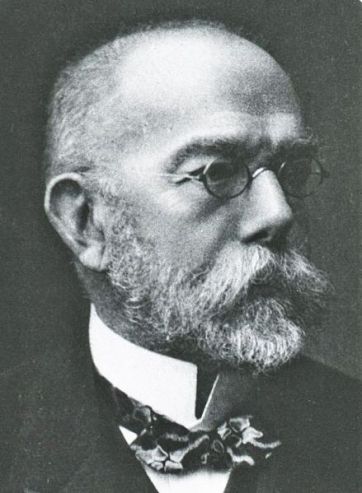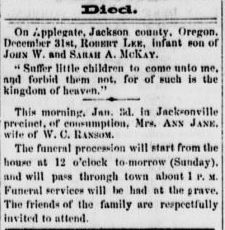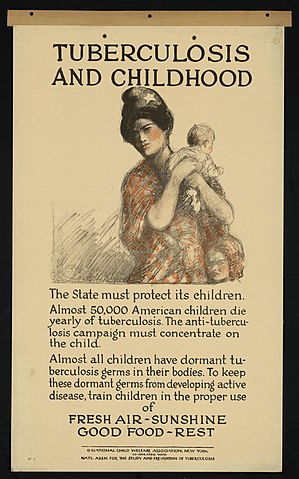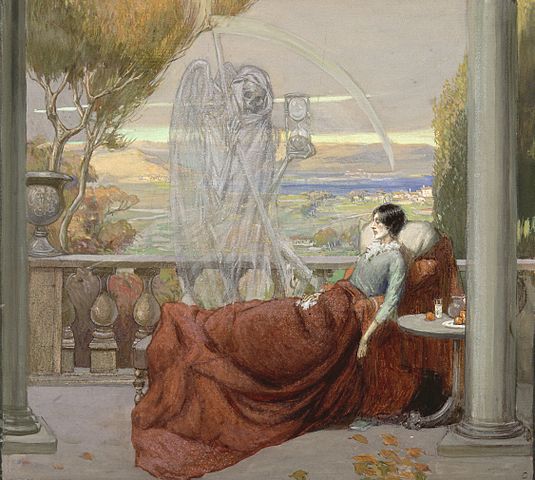By Eilene Lyon — March 24, 2020
It felled Egyptian Pharaohs and Greek warriors. It’s likely been around for 9,000 years or more. An estimate is that one in seven people who ever lived prior to 1800 succumbed to the disease, caused by a bacterium. Is this one of those plagues that have been eradicated by modern medical miracles? Unfortunately, no.
As much as a quarter of the world’s population carries it (mostly latent, not active), and over a million still die every year. What is this contagious disease? Tuberculosis (TB), also known as consumption, phthisis or White Plague.
On this date in 1882, German physician and microbiologist Dr. Robert Koch presented to the world his achievement of isolating the cause of this scourge: Mycobacterium tuberculosis. Prior to this revelation, many believed consumption to be a hereditary disease, since it appeared to run in families.

Koch also worked to isolate the agents causing cholera and anthrax, though he wasn’t the first to recognize the former. He is also credited with formulating four postulates that lead to such discoveries:
- The organism must always be present, in every case of the disease.
- The organism must be isolated from a host containing the disease and grown in pure culture.
- Samples of the organism taken from pure culture must cause the same disease when inoculated into a healthy, susceptible animal in the laboratory.
- The organism must be isolated from the inoculated animal and must be identified as the same original organism first isolated from the originally diseased host.
Though there are no reliable death statistics prior to the 20th century, those who study TB believe that cases peaked from the late 18th to late 19th centuries. As many as half the deaths in people aged 15 to 35 were caused by consumption during that period. It was the leading cause of death worldwide in the 1800s.
It’s unlikely that the people in your family tree were unscathed by TB, though there may not be a record for cause of death in many cases. One known death due to consumption in my family history was Ann Jane (Jenkins) Ransom (1831-1863). It’s probable that some of her siblings who died fairly young also had it.

It’s hard to say just when Ann began experiencing symptoms, as she seems to have had long-term health issues (as did her brother, Bedford, who died at age 47). Her husband, William C. Ransom, who became a doctor years after Ann died, attempted to treat her, without success.
In 1855, Ann, then living in Amador City, California, sent a letter to her parents in Indiana that demonstrates a sadly fatalistic attitude:
“I said I had never been down sick since in this country neither have I but I am nearer that this week than I would like to be I have taken a heavy cold and it seems to affect me all over especially in my heart and shoulders pa [her husband] is going to get me some medicine to cleanse my liver and I have taken a large dose of pills I think when I get that I will be better but mother thee knows I never have calculated on a long life here and what does it matter God has promised to uphold those that look to him with an eye of faith and I dont feel anyways disposed to doubt his word…”

Ann left behind five devastated children, two of whom would soon follow her to the grave. Her three daughters’ lives would never be the same, taking a turn for the worse. How many children suffered the loss of one or both parents from this illness? It staggers one to consider the implications.
Two of Ann’s sisters who may have died from TB were Philadelphia Barr and Mary Clouse. Philadelphia never had children, and it’s clear from her obituary that some type of illness caused her death at 39, though it states it was of short duration. I have no obituary for Mary, mother of five, who was just 30 when she died.
As TB became known as an infectious disease, those who did not suffer from it tended to shun and isolate those who did, not unlike the way people treated lepers. Sanatoriums took in large numbers of patients. Fresh air and a mild climate were touted as beneficial.

On the bright side, TB is now treatable and need not be a death sentence. That so many still suffer and die is tragic. Two primary risk factors are smoking and HIV/AIDS. Taking immunosuppressing drugs tends to activate the bacilli in those with HIV. Treatment is with a combination of antibiotics.
This map shows the annual incidence of active TB cases worldwide in 2017. In the U.S. most cases are found in people born in other countries. We in the developed world have low chances of ever getting TB, but we shouldn’t ignore the fact that it is still a leading deadly infection in other parts of the globe.

Feature image: Watercolor by Richard Tennant Cooper (Wikimedia Commons)
Ann Jane Jenkins on Ancestry.com
Sources:
Letter (transcript) from Ann Ransom to Abigail and Henry Jenkins, April 17, 1855. Henry Jenkins Correspondence folder of the C. J. Brosnan Collection. University of Idaho Special Collections.
“In Memorium: Philadelphia D. Barr” The Portland (Indiana) Commercial, January 4, 1877.
https://en.wikipedia.org/wiki/History_of_tuberculosis
https://www.pbs.org/wgbh/americanexperience/features/plague-gallery/
https://www.thedailybeast.com/when-tb-was-a-death-sentence-an-excerpt-from-the-remedy
https://en.wikipedia.org/wiki/Robert_Koch
https://en.wikipedia.org/wiki/Tuberculosis
https://en.wikipedia.org/wiki/List_of_tuberculosis_cases (well-known people who suffered or died from TB)

“Train children in the proper use of FRESH AIR – SUNSHINE – GOOD FOOD – REST”
I do like that plea. Seems applicable today. I knew that TB killed many people but not the details about how it did so. Fascinating as usual.
LikeLiked by 2 people
That poster really brought it home, especially since it’s just 100 years old. The statement that almost all children have a latent infection was sobering.
LikeLiked by 2 people
Very interesting, especially in today’s climate. Well done as always
LikeLiked by 2 people
Thank you. I found it very interesting to see the scientific process at work with Koch, back in the day when modern germ theory was in its infancy.
LikeLiked by 2 people
My daughter has a history class this semester and for the final they’re being given the option to write about the crisis and it will be documented at the school. I think that’s a wonderful idea
LikeLiked by 2 people
That will be an interesting historical record, for sure!
LikeLiked by 2 people
An interesting read, and so sad. I remember getting the scratch test for TB when working in Vancouver.
LikeLiked by 2 people
I think I had a test done when we lived in Guatemala, but not 100% sure.
LikeLiked by 1 person
I had to have it done for a job working at the Boys and Girls Club in downtown Vancouver. We’ve certainly come a long way in our knowledge of infectious disease, and yet, we still have a way to go…
LikeLiked by 1 person
There are so many diseases that used to be deadly that aren’t anymore, so I’m hopeful. But dense populations are really at risk, no matter what we learn.
LikeLiked by 1 person
I had to get one when I applied to substitute each in the public schools in the late 1980s in Virginia.
LikeLiked by 2 people
What shakes me is the travel aspect. Five hundred years ago, these diseases made it to every single continent WITHOUT the benefit of air travel. In today’s world, it is so much easier for this stuff to go global.
LikeLiked by 2 people
Amazing, yes. Some people back then never went anywhere while others roamed quite widely. There’s always been the restless, adventurous contingent. No airplanes required!
LikeLiked by 1 person
Without planes or Jeeps. True adventurers. . .
LikeLiked by 1 person
Camel, horse, boat, elephant, foot, hot air balloon…
LikeLiked by 1 person
Have mode of transportation, will adventure!
LikeLiked by 1 person
John’s mother had TB in the 1950s, before he was born. I’ve just been reading an article about it in a Scottish newspaper: there was an epidemic in Edinburgh in 1954, so I guess that must have been when it was. (The family only moved to Glasgow when John was 6 months old). It was around that time that an effective drug cocktail was developed by (I think) Dr John Crofton so maybe she was lucky to be treated with that. My life could have been very different!
LikeLiked by 2 people
Thanks for sharing that story, Anabel. I don’t have any personal knowledge of someone in recent memory with TB. We tend to think that some of these infectious agents should be easy to kill/cure, but they aren’t. I was actually surprised to learn how many people still die of this disease every year – about 1.6 million!
LikeLiked by 1 person
It was actually rising again in the UK, but I think it’s fallen back now. Shocking!
LikeLiked by 1 person
I was surprised as well.
LikeLiked by 1 person
Poor Ann and her family 😦 I especially enjoyed reading that letter. Seems like she had a lot of courage despite what she faced.
LikeLiked by 2 people
Just making the trip to California with her brother and almost 4-year-old daughter in 1853 – holy cow. Yeah, she was brave.
LikeLiked by 2 people
My husband and I often talk about the metal they must have been made of to travel across the rugged country back then!
LikeLiked by 1 person
They actually went by sea, across Panama. I’m not sure if they went to New York or New Orleans first. They didn’t leave a record, unfortunately. The earlier trips (her father, later her husband) went via New Orleans.
LikeLiked by 1 person
Oh gosh, even worse! I get sea sick looking at a boat! 🙂
LikeLiked by 1 person
My only experience with TB has been scratch tests when I was a student in a medical program.
Other than that, I am aware of the former sanitoriums… (sanitoria?) in the various communities I have lived in… and their history, but I have no direct experience of them.
For which I am grateful.
Hope you are well.
LikeLiked by 2 people
I wonder what became of all those sanatoriums. I suppose many were repurposed as hospitals or asylums, or maybe just torn down.
LikeLiked by 2 people
The one I know from London Ontario was “re-purposed” as a facility for people with behaviour problems related to developmental delays – the building is still in use today. In Haileybury, near where I live today, the building was a teaching hospital, run by the church. It still stands as an apartment building – I’m not sure if it is deemed “assisted living” but I do know many seniors live here and make use of day programs.
LikeLiked by 1 person
Wonderful! Thanks for sharing that information.
LikeLike
An interesting and sobering post.
LikeLiked by 1 person
I think it’s easy to put out of mind those infectious diseases that aren’t likely to affect me, personally. When I researched this, it came as a surprise to me how bad the TB situation still is.
LikeLiked by 1 person
Fascinating post, as usual. And such a grim photo of poor Ann. I liked how she wrote of her faith: …”I dont feel anyways disposed to doubt his word…”
You feel her sense of helplessness.
LikeLiked by 1 person
Having all those kids to care for when she was ill must have been a terrible strain. A much too short life, but certainly an adventurous one!
LikeLiked by 1 person
Wow, Eilene. This was so helpful! Not only did George die of this disease, but my great-grandfather had TB that he got from his mother and his adult brother died from it. One relatives thinks his mother brought it with them from the Netherlands when she came at about age 20 and she was already a mother. Her firstborn died just after they got here? Did he have it? Not sure we’ll ever know.
LikeLiked by 1 person
I have so many relatives who died young of unknown causes that I suspect many of them had TB. I know of several in the Ransom family who died of it. Highly contagious, but so many never get sick. It’s a worldwide infection.
LikeLike